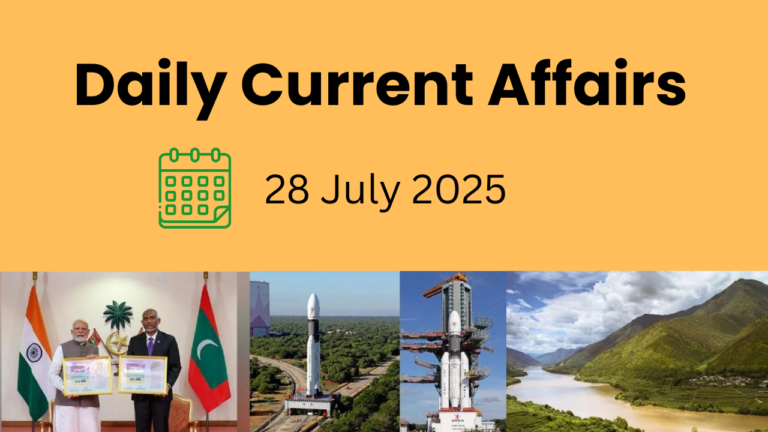1. India Champions WTO Reform at Paris Ministerial Meet
Context: At the WTO Mini-Ministerial Meeting held in Paris in 2025, India emerged as a vocal advocate for strengthening the multilateral trading system, calling for a comprehensive overhaul of the World Trade Organization (WTO) to better reflect the interests of developing economies. The high-level meeting saw participation from 25 member countries, amidst growing challenges to the global trading order.
India’s Bold 3-Pronged Reform Strategy:
India outlined a focused, three-point reform agenda aimed at revitalizing the WTO, making trade more equitable, and curbing practices that undermine the rules-based system.
1. Combatting Non-Tariff Barriers (NTBs):
India stressed the need to tighten global oversight on NTBs, such as Sanitary and Phytosanitary (SPS) measures and Technical Barriers to Trade (TBT), which are increasingly used as hidden protectionist tools by developed nations.
- Example: Indian exports like mangoes and basmati rice frequently face rejections in EU and U.S. markets over alleged SPS violations, despite meeting quality standards.
- India’s Ask: Greater transparency, scientific justifications, and non-discriminatory standards across WTO members.
2. Addressing Distortions by Non-Market Economies:
India raised concerns over state-driven economic models, particularly targeting nations like China, where heavy subsidies, export dumping, and opaque trade practices have disrupted global markets.
- Example: India’s steel and solar panel industries have suffered due to cheap imports from China, leading to imposition of safeguard duties and anti-dumping investigations.
- India’s Ask: Clear definitions, disciplines on subsidies, and greater transparency in trade practices of non-market economies.
3. Restoring the WTO Dispute Settlement Mechanism:
India underlined the urgent need to revive the WTO Appellate Body, which has remained non-functional since 2009 due to a U.S. blockade on judicial appointments.
- Example: Several key disputes involving India—such as those related to U.S. steel tariffs and ICT import duties—remain unresolved.
- India’s Ask: A binding, independent, and impartial dispute resolution process to restore credibility and fairness in trade adjudication.
Why WTO Still Matters in a Changing Global Landscape:
Despite facing challenges, the WTO remains vital to global economic governance, especially in a multipolar world where trade tensions are rising and geopolitical rivalries intensifying.
- Dispute Resolution: A neutral mechanism to manage frictions among major powers like India, China, the U.S., and the EU.
- Rule-Making for the Future: With emerging areas like digital trade, e-commerce, and artificial intelligence, global rules are more essential than ever.
- Protection for Developing Nations: Helps prevent unilateralism and bullying by richer economies, ensuring a level playing field.
- Streamlined Trade: Facilitates smoother trade through common customs and trade procedures, reducing transaction costs.
Why Reform is Not Just Necessary—It’s Unavoidable:
India emphasized that the current system is at a critical inflection point:
- Surging Protectionism: Trade wars like the U.S.-China standoff have often bypassed WTO norms.
- Plurilateralism Risk: Initiatives such as the Investment Facilitation for Development (IFD) are backed by over 128 nations, but lack full consensus—potentially weakening multilateralism.
- Unresolved Development Issues: Key demands from the Global South, like a permanent solution for public foodgrain stockholding, remain pending since the Bali Ministerial of 2013.
Conclusion: India’s Reform Drive—Pragmatic, Principled, and Timely
India’s push for WTO reform reflects a balanced vision—protecting the WTO’s developmental ethos, resisting fragmented trade deals, and modernizing its core structures for future relevance. As global trade faces increasing uncertainty, India’s leadership in reviving the WTO could help restore faith in multilateralism and build a more inclusive, transparent, and just global trading order.
2. EnviStats India 2025: A Comprehensive Snapshot of India’s Environmental Trends
Context: In a significant breakthrough, experts from the Wildlife Institute of India (WII), Dehradun, have successfully collared three endangered Fishing Cats (Prionailurus viverrinus) in Coringa Wildlife Sanctuary (CWS) — a first-of-its-kind effort in India. This initiative aims to monitor the species’ habitat range, behavioural patterns, breeding habits, and prey preferences, providing vital insights for future conservatin strategies.
About Coringa Wildlife Sanctuary:
Nestled in the Kakinada district of Andhra Pradesh, Coringa Wildlife Sanctuary forms an integral part of the Godavari estuarine ecosystem, where the Coringa River merges into the Bay of Bengal. This sanctuary is a unique blend of mangrove swamps, tidal creeks, and sea backwaters, with about 40% of the area submerged under backwaters and tidal influence.
Vegetation and Forest Types:
Coringa boasts India’s second-largest expanse of mangrove forests, characterized by a mix of mangroves and dry deciduous tropical forests.
- Dominant Mangrove Flora: Species such as Rhizophora spp., Avicennia spp., and Sonnertia spp. flourish here, forming a dense green barrier between land and sea.
Diverse Wildlife at Coringa:
This biodiversity-rich zone supports an array of endangered and endemic wildlife species:
- Mammals: The sanctuary shelters endangered species like the Smooth-coated Otter, Fishing Cat, and Indian Jackal.
- Birds: Coringa is a paradise for birdwatchers. Black-capped Kingfishers, Brahminy Kites, Reef Herons, Sandpipers, and Sea Gulls are common sights among the mangroves.
- Marine Life: Its coastline serves as a crucial nesting site for Olive Ridley Turtles, a globally threatened marine species.
Spotlight: The Fishing Cat
Physical Traits:
The Fishing Cat is a medium-sized wild cat with a robust, muscular build, short limbs, and a rounded but elongated face. Females are typically smaller than males.
Habitat Preferences:
Fishing cats thrive in wetland ecosystems, including:
- Mangrove forests
- Swamps and marshlands
- Reed beds and tidal creeks
- Oxbow lakes and river deltas
Their strong swimming skills allow them to pursue aquatic prey such as fish, frogs, and even small crustaceans.
Behavioural Characteristics:
They are solitary, nocturnal hunters who prefer to rest in thick vegetation during the day. At night, they become active near water bodies in search of food.
Geographical Distribution of Fishing Cats:
- India: Found predominantly in the Sundarbans mangroves, foothills of the Himalayas, Ganga-Brahmaputra floodplains, and parts of the Western Ghats.
- International Range: Extends across Southeast Asia, including Sri Lanka, southern China, Java, Sumatra, and even some regions of Pakistan and Western India.
Conservation Status of the Fishing Cat:
- IUCN Red List: Vulnerable
- CITES: Appendix II
- Wildlife Protection Act, 1972 (India): Schedule I (highest level of protection)
Additional Insight: Why This Matters
The collaring of Fishing Cats at Coringa is a landmark achievement because:
- It enhances our understanding of rare wetland species in mangrove ecosystems.
- It helps develop species-specific conservation action plans.
- It promotes the importance of urban-wetland coexistence, especially in regions vulnerable to climate change and habitat degradation.
3. Tamil Nadu Declares Greater Flamingo Sanctuary in Dhanushkodi
Context: In a landmark decision for bird and habitat conservation, the Tamil Nadu Government has officially notified the creation of a Greater Flamingo Sanctuary in Dhanushkodi, located in the Ramanathapuram district. This move marks a significant stride in protecting one of India’s most ecologically vital coastal zones, especially for migratory waterbirds.
About the Greater Flamingo Sanctuary:
The newly declared sanctuary is situated within the Gulf of Mannar Biosphere Reserve, a UNESCO-recognized ecological hotspot known for its rich biodiversity and fragile coastal ecosystems.
Key Features of the Sanctuary:
- Location: Dhanushkodi, at the southeastern tip of Tamil Nadu.
- Ecological Significance: Lies along the Central Asian Flyway, serving as a critical stopover and feeding ground for thousands of migratory birds, including both Greater and Lesser Flamingos.
- Habitat Diversity: The area encompasses mangroves, intertidal mudflats, marshes, sand dunes, and coastal wetlands, providing a mosaic of habitats.
- Avian Richness: Supports over 128 bird species, making it a key birding destination and ecological haven.
- Mangrove Ecosystems: Mangrove species such as Avicennia and Rhizophora play a vital role in shoreline protection and support a range of marine biodiversity, including fish, crustaceans, molluscs, and nesting sea turtles.
Greater Flamingo: The Icon of the Sanctuary
About the Species:
The Greater Flamingo (Phoenicopterus roseus) is the largest and most widespread flamingo species in the world. Known for its graceful posture, striking pink plumage, and specially adapted beak, this bird feeds by filtering small organisms like algae, diatoms, and crustaceans from shallow waters.
Distribution:
It is widely found across:
- Africa
- Western and South Asia
- Southern Europe
Preferred Habitats
The species thrives in:
- Saline and alkaline wetlands
- Coastal lagoons
- Salt pans
- Intertidal mudflats
- Inland salt lakes
These habitats are essential during the breeding season, where colonies gather in large numbers.
Conservation Status of the Greater Flamingo
- IUCN Red List: Least Concern, but local populations are sensitive to habitat loss and pollution.
- Indian Wildlife Protection Act (1972): Schedule-II, offering protection from hunting and exploitation.
Why This Sanctuary Matters:
- Biodiversity Hotspot: Part of the Gulf of Mannar, India’s first marine biosphere reserve, home to over 4,000 species of flora and fauna.
- Climate Resilience: Mangroves act as natural buffers against storms, cyclones, and sea-level rise.
- Ecotourism Potential: The sanctuary could become a major birdwatching and ecotourism site, boosting local livelihoods and community-based conservation.
Global Flyway Protection: The sanctuary strengthens India’s role in the Central Asian Flyway Initiative, a multilateral effort to conserve migratory birds across continents.
Did You Know?
The Greater Flamingo gets its pink coloration from carotenoid pigments in the crustaceans and plankton it consumes.
Dhanushkodi, once a bustling town destroyed by a cyclone in 1964, is now rising as a beacon for wildlife conservation and eco-restoration.
Conclusion: A Vision for a Flamingo-Friendly Future
The declaration of the Greater Flamingo Sanctuary reflects Tamil Nadu’s commitment to environmental protection, coastal ecosystem conservation, and the safeguarding of migratory bird habitats. As flamingos return seasonally to these rich wetlands, the sanctuary stands as a symbol of harmonious coexistence between humans and nature, and a model for sustainable coastal development across India.
4. India Moves to Build Strategic Stockpile of Rare Earth Magnets Amid Global Supply Risks
Context: In a significant move to bolster its technological self-reliance, India is in talks with private companies to establish long-term stockpiles of rare earth magnets. The government is planning to extend fiscal incentives to encourage domestic production, aiming to reduce dependence on China, which currently dominates over 90% of the global rare earth magnet processing capacity.
This initiative comes at a critical time, as China has recently tightened export controls on rare earth-related products, heightening global concerns about the stability and accessibility of these strategic materials.
What Are Rare Earth Magnets?
Rare earth magnets are a class of high-performance permanent magnets made from alloys of rare earth elements (REEs). They are known for their unmatched magnetic strength, compact size, and energy efficiency, making them indispensable in a wide range of high-tech applications.
Key Features:
- Exceptional magnetic force, often 10 times stronger than traditional magnets.
- Compact yet powerful, making them ideal for miniaturized electronics.
- High energy density, crucial for devices that require strong yet lightweight magnetic components.
These magnets are a cornerstone of modern technology, but their supply chain is heavily skewed, with China controlling a vast majority of both the mining and refining processes.
Types of Rare Earth Magnets:
The two main types of rare earth magnets are:
Neodymium Magnets (NdFeB)
- Composed of Neodymium, Iron, and Boron.
- Known as the strongest commercially available magnets.
- Widely used in electric vehicles, wind turbines, and consumer electronics.
Samarium Cobalt Magnets (SmCo):
- Composed of Samarium and Cobalt.
- Slightly less powerful than neodymium but more resistant to heat and corrosion.
- Often used in aerospace and defense applications.
Strategic Applications of Rare Earth Magnets:
Rare earth magnets are vital components in several cutting-edge and national security-related sectors, including:
- Medical Devices: MRI scanners, PET imaging, and X-ray machines.
- Defense and Aerospace: Guidance systems, jet engines, and drones.
- Consumer Electronics: Smartphones, headphones, and gaming consoles.
- Automotive Industry: Critical in the electric vehicle (EV) drivetrain and battery systems.
- Renewable Energy: Essential for high-efficiency wind turbines and solar tracking systems.
- Data Storage: Used in hard drives and advanced computing systems.
Understanding Rare Earth Elements (REEs):
Rare Earth Elements (REEs) comprise 17 chemical elements, including the 15 lanthanides, along with scandium and yttrium.
Key Points:
- Despite their name, REEs are not rare—they are relatively abundant, but difficult to extract and purify.
- Found commonly together in geological deposits, they require complex separation processes.
- Often sold as rare earth oxides due to their stable form in commercial usage.
Currently, China controls over 80% of the global refining and processing of REEs, giving it a strategic monopoly in the global supply chain—something many countries, including India, are actively seeking to counterbalance.
Why This Move Matters for India:
- National Security: Ensures supply chain resilience in defense and high-tech sectors.
- Economic Independence: Reduces reliance on imports for crucial inputs in emerging technologies.
- Green Energy Transition: Supports India’s push towards EVs and renewable energy.
- Global Positioning: Aligns India with efforts by the U.S., EU, Japan, and Australia to diversify rare earth sourcing.
Conclusion: Toward a Self-Reliant Magnet Economy
India’s focus on building a domestic ecosystem for rare earth magnets marks a crucial step toward achieving Atmanirbhar Bharat (self-reliant India) in strategic sectors. With the growing global race to secure critical mineral resources, this initiative could help India position itself as a key player in the future of green technology, defense manufacturing, and advanced electronics.
5. Thermophilic Bacteria: A Promising Weapon Against Antimicrobial Resistance
Context: Thermophilic bacteria—organisms that thrive in extremely hot environments like hot springs, deep-sea vents, and compost heaps—are emerging as key players in the fight against antimicrobial resistance (AMR). One such site of interest is Rajgir, located in Bihar, India, where unique microbial life is revealing its potential to combat drug-resistant pathogens.
The Study: Mining Microbial Riches with Metagenomics
- A scientific study conducted in the hot springs of Rajgir used 16S rRNA metagenomic analysis to explore the diverse microbial community, focusing particularly on organisms capable of producing antibiotic compounds. Metagenomics, the method of analyzing genetic material directly from environmental samples, allows scientists to identify microbes without the need to culture them—a revolutionary approach in microbial discovery.
A significant finding was the dominance of Actinobacteria, a phylum known to include species like Streptomyces, which are natural producers of important antibiotics such as streptomycin and tetracycline. In Rajgir, these bacteria made up approximately 40–43% of the microbial population, signaling high potential for novel antibiotic discovery.
One standout compound identified was diethyl phthalate, derived from a member of the Actinomycetales order. This substance exhibited strong antimicrobial activity against Listeria monocytogenes, a dangerous foodborne pathogen that poses serious health risks, especially to pregnant women, newborns, and individuals with weakened immune systems.
Why It Matters: A Natural Defense Against a Global Threat
- The rise of AMR—largely driven by overuse and misuse of antibiotics—has become one of the gravest health threats globally. The World Health Organization (WHO) has warned that if unchecked, drug-resistant infections could push global healthcare costs to over USD 1 trillion by 2050. Already, AMR contributes to longer hospital stays, higher medical costs, and increased mortality.
Finding natural antibiotics from thermophilic bacteria offers a sustainable and effective solution. These heat-loving microbes thrive in harsh, mineral-rich environments with low microbial competition, making them prolific producers of unique bioactive compounds that could become the next generation of antibiotics.
Beyond Medicine: Industrial and Agricultural Innovations
The benefits of thermophiles go beyond healthcare. For instance:
- The PCR enzyme, crucial for Covid-19 testing, is derived from Thermus aquaticus, a thermophile.
- In Leh, a bacterial consortium isolated from hot springs has been shown to promote plant growth, offering eco-friendly solutions for sustainable agriculture.
- In Saudi Arabia, thermophiles have demonstrated antimicrobial activity effective against gram-positive pathogens, reinforcing their global significance.
The Road Ahead: Exploring Untapped Microbial Frontiers
The microbial world, especially in extreme environments, remains vastly underexplored. Hot springs like those in Rajgir are natural bio-laboratories, harboring evolutionarily unique species with powerful biochemical properties. With advanced techniques such as metagenomics, bioinformatics, and synthetic biology, scientists are better equipped than ever to unlock their secrets.
Final Thoughts:
In the age of superbugs and rising antibiotic resistance, turning to nature—particularly thermophilic bacteria from India’s ancient hot springs—might be our best bet. These invisible warriors could help us win the battle against AMR and pave the way for breakthroughs in medicine, agriculture, and biotechnology.
6. India and Vietnam Forge Deeper Ties in Media and Entertainment
Context: In a significant step to enhance bilateral ties, India and Vietnam have agreed to expand cooperation in the media and entertainment sector. This decision was reached during a high-level meeting between India’s Minister of State for Information and Broadcasting and a Vietnamese delegation, underscoring the shared commitment to deepen cultural and creative engagement.
Key Areas of Collaboration:
The two nations identified several promising avenues for cooperation:
- Content exchange between national broadcasters like Doordarshan and Vietnam Television (VTV) to showcase each other’s cultural heritage.
- Joint film productions and co-hosted film festivals to strengthen cinematic ties.
- Capacity building in journalism, media management, and digital broadcasting technologies through training programs.
- Exchange programs involving media professionals, scholars, and film artists to foster professional growth and collaboration.
- Promotion of shared civilizational links, particularly in Buddhism, regional traditions, and historical narratives.
This partnership not only strengthens the entertainment ecosystem but also builds a bridge of soft diplomacy that enhances mutual understanding and people-to-people ties.
India–Vietnam Relations: A Strategic and Historic Bond: India and Vietnam celebrated 50 years of diplomatic relations in 2022, marking a robust and time-tested friendship. This relationship was further elevated:
- In 2016, from a Strategic Partnership to a Comprehensive Strategic Partnership during Prime Minister Narendra Modi’s visit.
- In 2020, the two nations adopted a “Joint Vision for Peace, Prosperity, and People.”
- In 2024, bilateral momentum continued through high-level exchanges and the signing of a Plan of Action (2024–2028) to implement strategic goals.
Trade and Economic Relations:
The bilateral trade between India and Vietnam stood at USD 14.82 billion (April 2023–March 2024), with:
- India’s exports at USD 5.47 billion.
- Imports from Vietnam totaling USD 9.35 billion, indicating a trade imbalance that needs to be addressed.
India’s potential in sectors like pharmaceuticals, textiles, IT services, and agriculture remains underutilized due to non-tariff barriers and logistical constraints.
Strong Defence and Security Ties:
India and Vietnam have steadily enhanced their defence partnership:
- Defence Cooperation MoU (2009) and Joint Vision Statement (2015) laid the foundation.
- In 2022, both nations signed a Joint Vision Statement on Defence Partnership till 2030.
- Defence Line of Credit (LoC) worth USD 500 million extended by India to Vietnam.
- In 2023, INS Kirpan was handed over to Vietnam—the first major Indian warship transfer to an ASEAN country.
- Regular joint exercises like VINBAX and PASSEX, along with maritime cooperation, highlight growing military synergy.
Regional and Global Synergy:
India and Vietnam share a common vision for a free, open, and inclusive Indo-Pacific. Key areas of global and regional coordination include:
- Vietnam’s support for India’s permanent membership in the UNSC.
- Collaboration in ASEAN, East Asia Summit (EAS), and Mekong frameworks.
- India backs Vietnam’s centrality under its Act East Policy.
Vietnam also joined India’s Coalition for Disaster Resilient Infrastructure (CDRI) and jointly issued a commemorative stamp celebrating cultural martial arts: Kalaripayattu and Vovinam.
Challenges in the Relationship:
Despite strong ties, certain challenges persist:
- China Factor: Both countries face maritime tensions with China but Vietnam remains cautious in openly aligning on regional security matters.
- Trade Deficit: The trade imbalance favors Vietnam, and FTA review under the ASEAN-India Trade in Goods Agreement (AITIGA) has progressed slowly.
- Connectivity Issues: Limited direct flights and logistics links impact tourism, trade, and people-to-people interactions.
- Naval Interoperability: Vietnam’s navy has more integration with China than with India, posing challenges for deeper maritime cooperation.
- Economic Divergence: Vietnam is closely tied to East Asian supply chains and is a member of RCEP, reducing dependency on India.
The Way Forward: Toward a Balanced and Dynamic Partnership
To unlock the full potential of India–Vietnam relations:
- Trade balance must be improved by boosting Indian exports and removing non-tariff barriers.
- FTA negotiations under AITIGA should be expedited.
- Enhance maritime cooperation through joint training, shipbuilding, and logistics support.
- Promote investments in digital technology, startups, and renewable energy.
- Deepen collaboration in media, education, and cultural diplomacy.
Additional Insight:
India is among the world’s largest film producers, and Vietnam’s rising interest in global cinema makes it a natural partner for co-productions, talent exchange, and storytelling around shared Asian values and Buddhist heritage.Conclusion: India and Vietnam’s collaboration in media and entertainment not only reinforces cultural connectivity but also acts as a catalyst for strategic, economic, and regional cooperation. As both nations face a rapidly evolving global order, their partnership—grounded in shared values and mutual respect—has the potential to shape a resilient and inclusive Indo-Pacific future.




